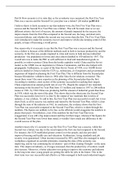Part B: How accurate is it to state that, as far as industry was concerned, the First Five Year
Plan was a success and the Second Five-year plan was a failure? (20 marks) p.205-212
I believe that it is fairly accurate to say that industry-wise, the First Five-Year Plan was a
success and the Second Five Year Plan was a failure. This will be made clear as we use
different criteria: the level of success, the amount of people impacted by the success, the
improvements from the First Plan compared to the Second one, the long- and short-term
successes/failures, and whether the second one was worse than the first. The Five-Year Plans
were introduced to make the economy recover and improve whilst also keeping control of the
people, in hope of becoming a world power.
One reason why it is accurate to say that the First Year Plan was a success and the Second
was a failure is because of the different methods used in both to increase productivity and the
economy. In the first one, people migrated to cities and towns to help increase industrial
production - the population in towns and cities almost doubled to 100 million by 1957. The
overall aim was to make the PRC as self-sufficient in food and manufactured goods as
possible, in order to protect China from the hostile capitalist world. China used the Soviet
model, as the USSR was an inspiration to Chinese Communists, and this also helped with
propaganda. Furthermore, as a part of the Sino-Soviet Treaty of 1950, over 10,000 Soviet
advisors landed in China to help the CCP e.g., technicians, civil engineers and governmental
organisers all helped in planning the First Year Plan. This is different from the Second plan
because Khrushchev withdrew them in 1960, after Sino-Soviet relations worsened. This
meant there wasn’t the same expertise in the planning of the Second plan than the first.
According to statistics, most sectors of the economy succeeded in reaching their targets.
China experienced an annual growth rate of over 9%. Despite the output of raw materials
increasing in the Second Five Year Plan from 131 million coal tonnes in 1957 to 200 million
tonnes in 1961, by 1962 China was producing half the amount of industrial goods than those
in 1958, which was the start of the plan. This shows that in the short term, the Second Year
Plan was successful, however it is clear by the output of raw materials that in terms of
industry, it was a failure. To add to this, the First Year Plan was successful overall, but it was
short-lived, as all its success was undone and ruined by the Second Year Plan, which is clear
through the state of the industry in 1962. In conclusion, the evidence shows that the First
Year Plan was successful compared to the Second Year Plan, which is evident through the
numbers. The figures are unlikely to be true, as the officials would exaggerate the numbers to
please their peers. Nevertheless, even if the numbers for the First Year Plan were
exaggerated, it was still a big improvement and they hit their target, whereas if the figures for
the Second Year Plan were lower than stated, it wouldn’t have made any difference to the
overall success of the plan.
Another reason why it’s accurate to say the First Five Year Plan was a success, whilst the
Second was a failure was due to the social impacts the First one had compared to the Second.
For instance, the CCP established greater control over the people, and also provided
improved housing and health care and education. Furthermore, living standards and job
security were guaranteed. Urban incomes increased by 40%, and Mao also managed to make
workplaces organised on socialist principles, meaning the state of the economy was
improving, and he was continuing the revolution - part of Mao Zedong Thought - at the same
time. This improved industry, as if wages increased, then the productivity of workers would
also increase. Moreover, a better education was going to improve the economy and industry
in the long term since young people are getting the skills for jobs in the future. This in the
short term was very successful and effective as Mao managed to both reach industrial targets




